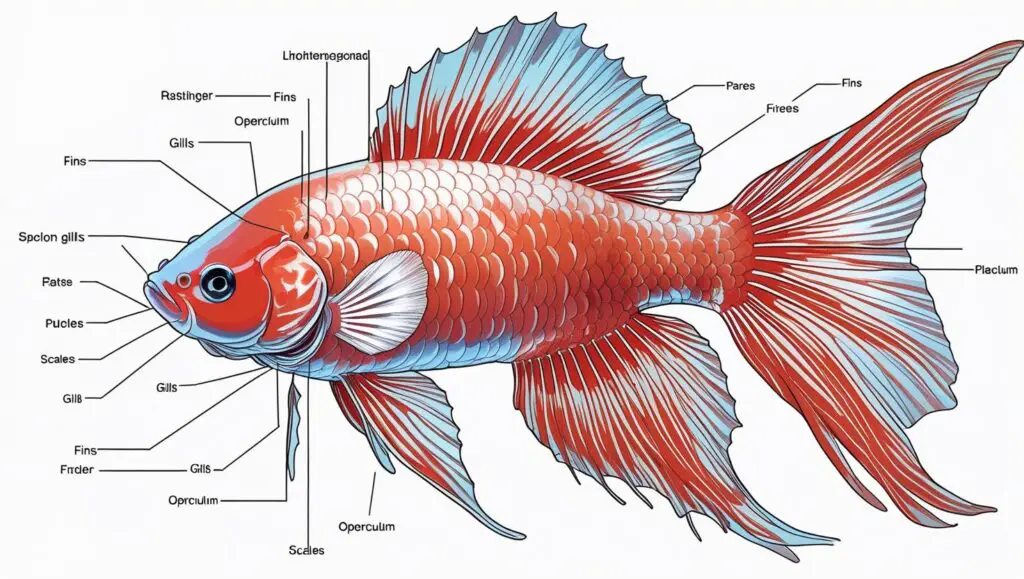The Siamese fighting fish, commonly known as the Betta fish, is one of the most visually striking and behaviorally fascinating freshwater species in the aquarium hobby. Their vibrant colors and elaborate fins make them a favorite among aquarists, but to properly care for and appreciate these magnificent creatures, it’s crucial to understand their anatomy. This in-depth guide explores the body parts of Siamese fighting fish, offering an extensive look at their structure and function.
Head and Sensory Organs of Betta Fish
Eyes
Betta fish have large, prominent eyes located on either side of their head, granting them a wide field of vision. Despite lacking eyelids, they have excellent motion detection and are especially sensitive to light and shadow changes. Betta fish can detect colors and distinguish between different shapes, which is essential for identifying prey, mates, and rivals.
Nostrils (Nares)
Located above the mouth, Betta nares function similarly to nostrils in other animals. These small holes allow the fish to “smell” the water, helping them detect pheromones, food particles, and chemical signals, which are vital for communication and environmental awareness.
Mouth and Jaw
The upturned mouth of the Siamese fighting fish is perfectly adapted for surface feeding. Bettas are opportunistic carnivores, and their sharp, tiny teeth help grip and tear apart small insects and larvae. Males also use their mouth to construct bubble nests, a crucial behavior in their reproductive process.

Gill System and Respiratory Adaptations
Gills
Like all fish, Bettas rely on gills to extract oxygen from water. Their gill covers (opercula) are the bony plates that open and close rhythmically, allowing water to flow over the gill filaments where oxygen exchange occurs. Healthy gills are bright red or pink, signaling efficient respiration.
Labyrinth Organ
What sets Betta fish apart is the labyrinth organ, an evolutionary adaptation allowing them to breathe atmospheric air. This complex vascularized structure acts like a lung, enabling the fish to survive in low-oxygen waters such as rice paddies and stagnant ponds. You may observe your Betta surfacing periodically to gulp air—this behavior is entirely natural.
Fins and Their Functions
Caudal Fin (Tail Fin)
The caudal fin, or tail fin, is the most visually flamboyant part of the Betta’s body. It aids in propulsion and steering. The fin shape varies significantly between different Betta types:
- Veiltail – Long, flowing, downward-sloping tail
- Crowntail – Spiky, fringe-like edges
- Halfmoon – A dramatic, 180-degree spread
- Plakat – Short, traditional fighting style tail
The size and shape of the caudal fin often influence swimming agility and speed.
Dorsal Fin
Positioned along the top of the fish, the dorsal fin helps maintain stability and balance. Its size and ornamentation vary depending on the Betta type. An erect dorsal fin is typically a sign of good health and alertness.
Anal Fin
Running along the underside of the body, just behind the ventral region, the anal fin plays a critical role in stabilizing and guiding the fish as it swims. It often extends into a dramatic point in males, contributing to their majestic appearance.
Pelvic Fins (Ventral Fins)
These paired fins, located below the gill covers, are used for precision movements, helping the fish navigate tight spaces and hover in place. In males, pelvic fins are often long and colorful, sometimes edged with white or iridescent tips.
Pectoral Fins
Positioned just behind the gills on either side, pectoral fins control fine movements, steering, and braking. These fins are in constant motion and are among the first indicators of the fish’s mood or health status. Healthy Bettas exhibit quick, symmetrical pectoral fin movement.

Scales and Skin
Scale Structure
Betta fish are covered in tiny overlapping scales made of keratin, which provide protection from injury and infection. These scales are coated with a mucus layer that acts as a barrier against parasites and bacteria.
Coloration and Iridophores
Bettas owe their stunning coloration to specialized cells called chromatophores and iridophores, which reflect light in complex ways. Colors can change due to stress, disease, or mood—a phenomenon known as metachrosis. Healthy, vibrant coloration is typically a sign of well-being and dominance, particularly in males.
Internal Anatomy Overview
Digestive System
The digestive tract of a Betta fish is relatively short, reflecting their carnivorous diet. From the mouth, food travels through the esophagus into the stomach, where digestion begins. Nutrients are absorbed in the intestines, and waste is expelled through the vent. Siamese Fighting Fish
Swim Bladder
The swim bladder is a gas-filled organ that allows the Betta to control its buoyancy. Malfunction of this organ can result in a loss of balance, often misdiagnosed as “swim bladder disease.” Proper diet and water quality are essential for its health. Siamese Fighting Fish
Kidneys and Excretory System
Betta fish have paired kidneys that regulate osmoregulation and waste removal. They constantly work to maintain a balance between water and salts, critical in freshwater environments. Siamese Fighting Fish
Reproductive Organs
- Males possess testes and release milt (sperm) during spawning.
- Females have ovaries that produce and store eggs.
During mating, males wrap around the female in a “nuptial embrace,” and fertilization is external. The male collects the eggs into a bubble nest, where he guards and cares for them until hatching. Siamese Fighting Fish
Unique Features in Male vs. Female Bettas
Male Betta Traits
- Larger, more vividly colored body
- Longer, flowing fins
- Aggressive and territorial behavior
- Bubble nest building
Female Betta Traits
- Smaller, with rounder bellies
- Shorter fins
- Ovipositor spot visible near the vent
- Less aggressive, though still capable of asserting dominance
Conclusion: A Masterpiece of Evolutionary Design
The Siamese fighting fish is not only a spectacle of beauty but also a marvel of anatomical specialization. From their air-breathing labyrinth organ to their color-shifting scales and precise fin movements, every body part plays a critical role in their survival, communication, and reproduction.
Whether you’re a seasoned aquarist or a beginner, understanding Betta anatomy enhances your ability to provide optimal care, recognize signs of disease early, and fully appreciate the complexity of this stunning species. Siamese Fighting Fish


Leave a Reply to Jawless Fish Characteristics: A Deep Dive into Agnatha Cancel reply